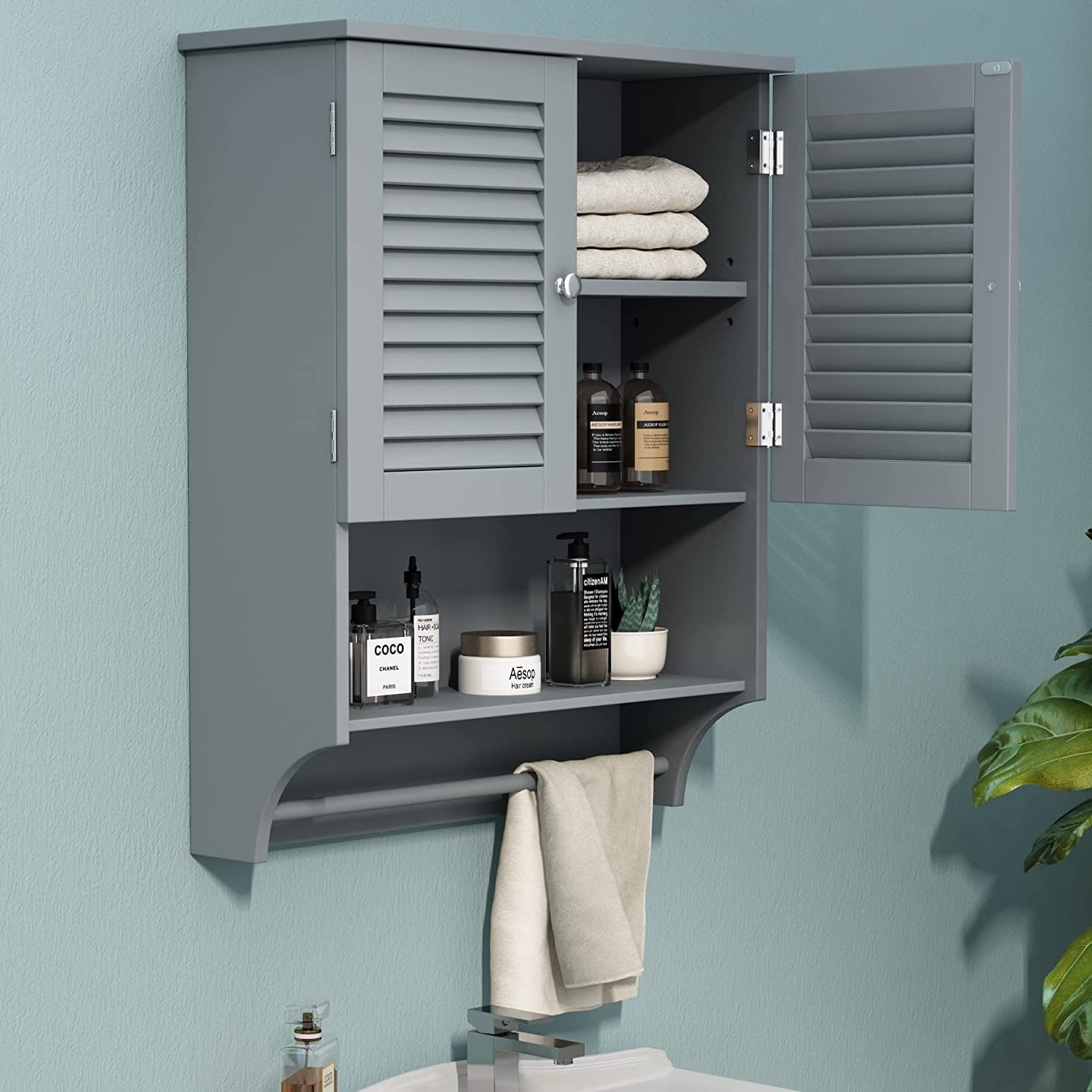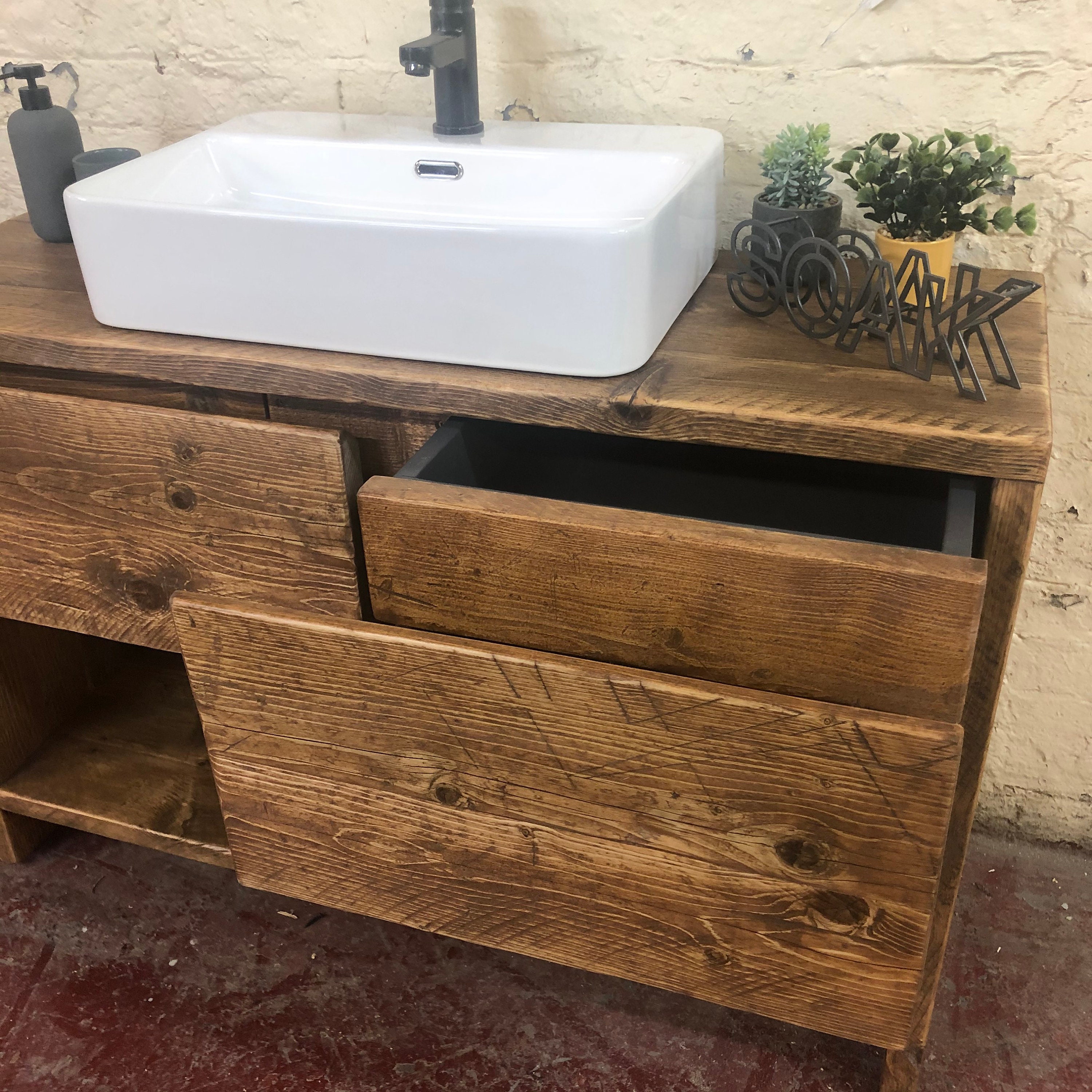Upcycling Techniques for Bathroom Wall Cabinets

Giving a second life to old bathroom cabinets is an act of both environmental consciousness and creative expression. Upcycling these forgotten pieces can transform them into functional and stylish focal points, breathing new life into your bathroom space.
Painting, Upcycled bathroom wall cabinet
Painting is a fundamental upcycling technique, offering a vast array of possibilities to refresh and revitalize old cabinets.
- Choosing the Right Paint: The type of paint chosen depends on the existing surface and desired finish. For example, using a primer before applying paint helps to ensure better adhesion and a smoother finish. Consider using chalk paint for a vintage look, or epoxy paint for a durable, moisture-resistant finish in high-humidity areas.
- Color Palette: Choosing the right color palette can transform the look of your bathroom cabinet. A bold, contrasting color can make a statement, while a soft, muted shade can create a more calming ambiance. For a modern look, consider using metallic paints or even chalkboard paint for a personalized touch.
- Adding Texture: Painting techniques can also add texture and depth to your cabinet. Using stencils to create patterns, applying a distressed finish with sandpaper, or even layering different paint colors can enhance the visual appeal.
Sanding
Sanding is a technique used to smooth out rough surfaces, remove old paint, or create a distressed look.
- Removing Old Paint: Sanding can help remove old, chipped, or peeling paint, preparing the surface for a fresh coat. This can be a time-consuming process, but it is essential for achieving a smooth and even finish.
- Creating a Distressed Look: Sanding can be used to create a distressed, vintage aesthetic. This involves selectively sanding down areas to expose the wood underneath, giving the cabinet a worn and aged look.
- Smoothing Rough Surfaces: Sanding can be used to smooth out rough surfaces, such as scratches or imperfections, preparing the surface for painting or staining.
Adding Decorative Elements
Adding decorative elements can elevate the aesthetic appeal of your upcycled bathroom cabinet.
- Hardware: Replacing old cabinet knobs or pulls with new, stylish ones can instantly refresh the look. Consider using vintage-inspired hardware for a classic feel or modern, minimalist pieces for a contemporary aesthetic.
- Mirror Tiles: Mirror tiles can add a touch of glamour and visual interest. They can be strategically placed on the cabinet doors or sides, reflecting light and creating an illusion of more space.
- Wallpaper: Adding wallpaper to the inside of the cabinet doors or the back panel can create a unique and personalized touch. Choose a wallpaper pattern that complements the overall bathroom decor.
Repurposing Cabinet Doors
Repurposing cabinet doors can transform them into functional and stylish elements.
- Creating a Mirror: Attaching a mirror to the back of a cabinet door can create a functional and decorative element. This is especially useful for small bathrooms, where mirrors can help to create an illusion of more space.
- Adding Storage: Repurposing the doors as shelves or dividers can create additional storage space within the cabinet or elsewhere in the bathroom. This is a great way to maximize space and organize toiletries and other bathroom essentials.
- Using as a Canvas: Cabinet doors can be used as a canvas for creative expression. They can be painted, decoupaged, or adorned with fabric to create unique and personalized pieces.
Design Inspiration and Ideas for Upcycled Bathroom Wall Cabinets

The charm of an upcycled bathroom wall cabinet lies in its ability to transform a forgotten piece into a statement of unique style. From rustic to modern, each design approach offers a distinct personality for your bathroom sanctuary.
Exploring Design Styles for Upcycled Bathroom Wall Cabinets
Upcycled bathroom cabinets can be tailored to different design aesthetics, reflecting the overall style of your bathroom. The following are some popular styles:
- Rustic: Embrace the warmth and character of natural materials by leaving the cabinet’s wood grain exposed. Consider using distressed finishes, salvaged hardware, and open shelves for a touch of vintage charm. A rustic cabinet would blend seamlessly with a bathroom featuring exposed brick, stone accents, and reclaimed wood elements.
- Modern: A sleek and minimalist approach is key to a modern bathroom. Choose a cabinet with clean lines, smooth surfaces, and a simple color palette. Opt for polished chrome or brushed nickel hardware to enhance the contemporary feel. A modern upcycled cabinet would complement a bathroom with geometric tiles, bold lighting, and contemporary fixtures.
- Minimalist: Simplicity reigns supreme in a minimalist bathroom. Select a cabinet with a simple design, devoid of excessive ornamentation. A neutral color palette, such as white, gray, or black, creates a sense of calm and serenity. Minimalist hardware, such as simple knobs or pulls, complements the understated aesthetic. A minimalist cabinet would blend effortlessly with a bathroom featuring a neutral color palette, open spaces, and minimal décor.
- Eclectic: For a bathroom that reflects your unique personality, embrace the eclectic style. Mix and match different textures, colors, and patterns. A vintage cabinet with a bold paint job or patterned wallpaper can add a touch of whimsy and personality. An eclectic cabinet would thrive in a bathroom that incorporates vintage finds, unexpected textures, and a vibrant color scheme.
Incorporating Upcycled Cabinets into Bathroom Layouts
The placement of an upcycled cabinet can greatly impact the overall flow and functionality of your bathroom. Consider these layout ideas:
- Small Bathrooms: Maximize space by choosing a compact cabinet or utilizing vertical space with a tall, narrow cabinet. Opt for a light color scheme and mirrors to create an illusion of spaciousness. A small upcycled cabinet could be placed above the toilet or in a corner to add storage without taking up valuable floor space.
- Master Bathrooms: Embrace a luxurious feel with a spacious cabinet that provides ample storage for towels, toiletries, and personal items. Consider using a statement piece with intricate details or a custom finish to add a touch of grandeur. A large upcycled cabinet could be placed near the vanity or along a wall to create a focal point in the bathroom.
- Guest Bathrooms: Create a welcoming atmosphere with a cabinet that reflects the overall style of your home. Choose a cabinet that is both functional and aesthetically pleasing. Consider adding decorative touches, such as a floral wallpaper or a vintage mirror, to enhance the guest experience. A charming upcycled cabinet could be placed above the sink or in a corner to provide storage for guest towels and toiletries.
Personalizing Upcycled Cabinets
- Unique Finishes: Beyond paint, consider incorporating unique finishes like decoupage, stenciling, or wood burning to add a personal touch. These techniques can create intricate patterns, textures, and visual interest. A decoupage technique could be used to create a floral motif on a cabinet door, while wood burning could add a rustic touch with a personalized inscription.
- Hardware: Replace outdated hardware with new knobs or pulls that complement the cabinet’s style and your bathroom’s overall aesthetic. Consider using vintage hardware for a rustic look or modern, minimalist hardware for a contemporary feel. A cabinet with antique brass hardware could add a touch of vintage charm, while sleek chrome pulls could enhance the modern aesthetic.
- Storage Solutions: Maximize functionality by incorporating various storage solutions within the cabinet. Add shelves, drawers, or baskets to organize toiletries, towels, and other bathroom essentials. Consider using clear storage containers to keep items visible and easily accessible. A cabinet with adjustable shelves could be used to accommodate items of varying heights, while baskets could be used to organize smaller items like makeup brushes and hair accessories.
Practical Considerations and Tips for Upcycling Bathroom Wall Cabinets

Transforming an old bathroom wall cabinet into a stylish and functional piece requires careful planning and execution. This section will guide you through the practical considerations and essential tips for a successful upcycling project.
Essential Tools and Materials
A well-equipped toolbox is crucial for a smooth upcycling journey. Here’s a list of essential tools and materials:
- Sandpaper: Different grits for smoothing surfaces and removing old paint. Use coarse grit for rough sanding and fine grit for finishing.
- Paintbrushes: Choose brushes of varying sizes for different applications, such as applying paint, primer, and stain.
- Paint: Select a water-based or oil-based paint suitable for bathroom environments. Choose colors that complement your bathroom décor.
- Primer: A primer helps create a smooth surface for paint adhesion and prevents the old finish from bleeding through.
- Stains: If you prefer a natural wood finish, stains can enhance the wood’s grain and color.
- Hardware: Replace old hinges, knobs, and pulls with new ones that match your desired style. Choose rust-resistant hardware for bathroom use.
- Screwdriver: A Phillips head screwdriver is essential for removing and installing hardware.
- Measuring Tape: Accurately measure the cabinet’s dimensions for planning and hardware installation.
- Level: Ensure the cabinet is level when installing it on the wall.
- Safety Glasses and Mask: Protect your eyes and lungs from dust and fumes during sanding and painting.
Step-by-Step Upcycling Tasks
Upcycling a bathroom wall cabinet involves a series of tasks that need to be completed in a specific order. Follow these steps for a successful project:
- Remove Old Paint or Finish: Use sandpaper or a paint stripper to remove the old paint or finish. If using a stripper, follow the manufacturer’s instructions carefully. Wear protective gear, such as gloves and a mask.
- Sand the Surface: Sand the cabinet’s surface to create a smooth finish for painting or staining. Start with coarse grit sandpaper and gradually progress to finer grits.
- Clean the Surface: After sanding, clean the cabinet thoroughly with a damp cloth to remove dust and debris.
- Apply Primer: Apply a primer to the cabinet’s surface to create a smooth, even base for paint. Allow the primer to dry completely before proceeding to the next step.
- Paint or Stain: Apply paint or stain to the cabinet using a brush or roller. Apply thin coats and allow each coat to dry completely before applying the next.
- Install New Hardware: Replace old hinges, knobs, and pulls with new ones that match your desired style. Use a screwdriver to install the new hardware securely.
Maximizing Storage Space
Upcycled bathroom wall cabinets can be incredibly functional. Utilize these tips to maximize storage space:
- Utilize Organizers: Use drawer organizers, shelf dividers, and other organizers to create compartments for different items.
- Install Shelves: Add additional shelves to the cabinet to increase storage space. Consider using adjustable shelves for greater flexibility.
- Use Vertical Space: Utilize vertical space by installing hooks, hanging baskets, or other vertical storage solutions.
- Maximize Drawer Space: Use drawer dividers to separate items and keep them organized. This helps prevent clutter and makes it easier to find what you need.
Upcycled bathroom wall cabinets offer a sustainable and stylish alternative to traditional cabinetry, often incorporating repurposed materials for a unique aesthetic. While these DIY projects can be rewarding, for those seeking pre-made options, brands like Briarwood USA bathroom cabinets provide high-quality, durable choices.
The combination of upcycled and commercially available options allows homeowners to personalize their bathroom spaces with a focus on both style and sustainability.
The concept of an upcycled bathroom wall cabinet embodies a commitment to sustainability, repurposing existing materials to create a unique and functional element. This approach aligns with the broader design trend of incorporating vintage and reclaimed pieces, often seen in the context of transitional bathroom vanity cabinets.
Transitional design, known for its harmonious blend of traditional and contemporary elements, seamlessly integrates salvaged materials, lending a sense of character and history to the space.
